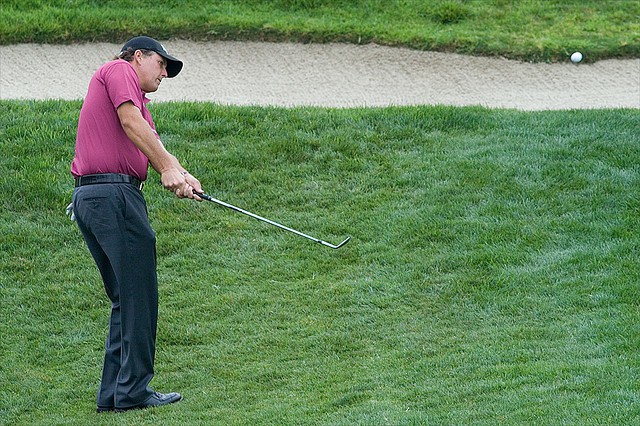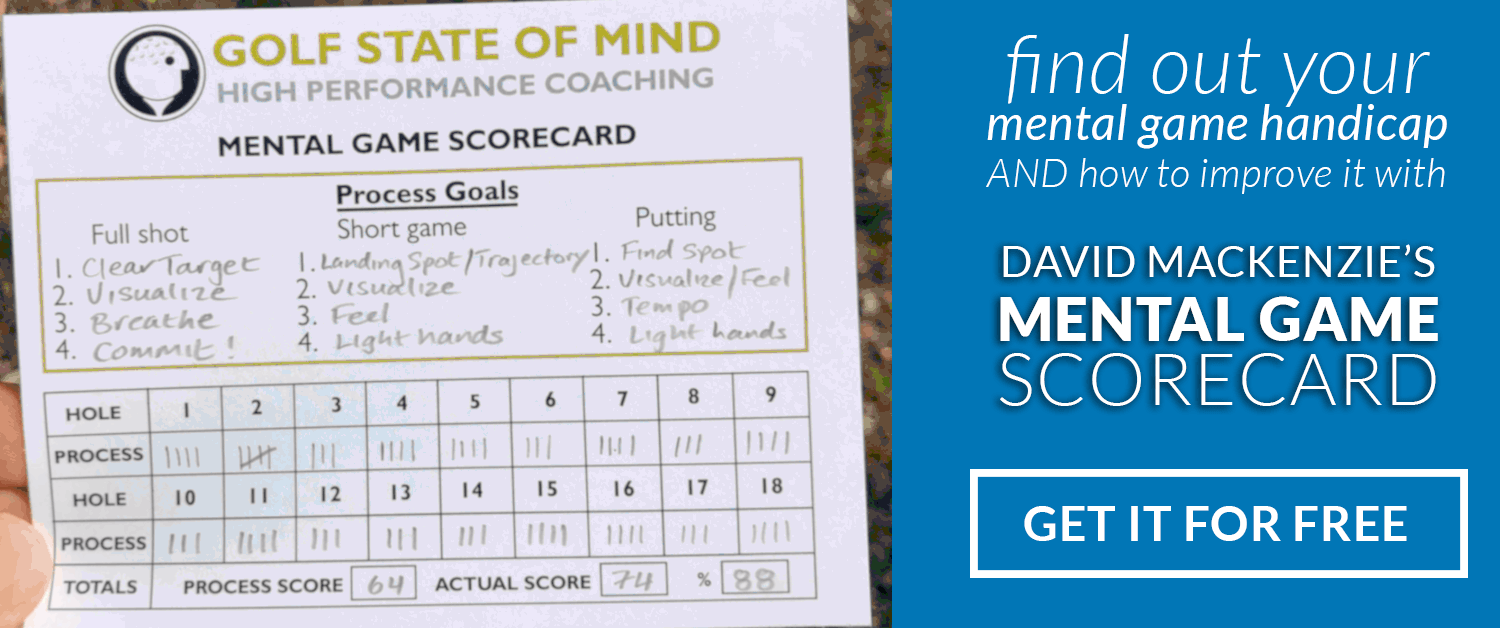
5 Top Tips to Improve Your Mental Game
The mental game of golf is a huge factor in any golfer reaching their potential. It’s all very well having good technical skills, but if you aren’t able to access them under pressure because you are tense, anxious and have trouble focusing, then you need help with the mental game of golf. The good thing about the mental game of golf is that it can be learned and improved just like you work on the technical aspects of your game. To help get you started, I’ve put together 5 of my top tips to improve your mental game.
1. Measure Success By Choosing Process over Results To Improve Your Mental Game
This one is simple. It’s key to remember that a good round of golf is a collection of individual shots played as best we can.
You have to be completely focused on the present moment, not thinking about anything else but what you’re about to do and the Shot Routine, or “Process” is the way to do it. I call it the shot routine, and not just the “pre shot routine” as it includes where your focus is right through until the end the of shot.
How you look, your score, your swing, everything has to be shut out for at least that 45-60 seconds from when it’s your turn, to when you put your club back in the bag.
This is why a shot routine is so important.
Every player will have their own variation on the steps they go through before a shot, but what you’ll notice when you watch the best players in the world, is that it’s the same every time, even down to the number of seconds it takes.
One of the best ways to improve your mental game is to work on honing a routine every time you practice and play, and measuring your success by how well you do it. You can do this by using my mental game scorecard.
It serves a couple of purposes – it gets you prepared for the shot. If you’re standing over the ball about to swing knowing you’ve done all you can in your preparation to execute that shot as best you can, you’ll swing a lot more confidently and aggressively at your target.
Secondly, that time before the shot is NOT the time to have any doubts or negativity. Thoughts about consequences create doubt and uncertainty – so simply following the steps of you routine meticulously, squeezes out any time for those counter-productive thoughts and keeps you firmly in the present moment.
As I said, there are several variations but my suggestion for a good shot routine is:
1. Analyze and choose the right shot to play (have a good course strategy)
2. Visualize that shot (shot shape) and pick precise targets
3. Feel that shot with a specific number of practice swings
4. Alignment – make sure you align correctly to your starting target
5. Breathing – a deep breath can get rid of any tension/nerves and improve focus (see below)
6. Go trigger – this could be a waggle, glances at the target, red dot on glove 🙂 whatever it is you need to do to say “I’m ready for action!”
7. Control your reaction with a post-shot routine- we’ll look at this one below
Make routine one of your goals for the round instead of shooting your best score.
2. Put yourself under pressure when you practice to improve your mental game
It’s really important that you simulate the golf course when you practice as much as possible. You need to create consequences instead of just reaching for another ball (you don’t have that luxury on the golf course).
The better you can get at handling the stresses and pressure of the golf course, the better you’ll play.
I know that some players (including Graeme McDowell) actually run on the spot during practice sessions to get their heart rate up – to better simulate how they feel on the course.
Create challenging games for yourself involving beating your best score each time.
A simple example would be to play a golf course on the driving range each time, reaching for different clubs and imagining holes, instead of just hitting to the same target over and over again (Ben Hogan used to do this).
This is a basic example, but the concept is that you give yourself consequences to your shots, just like there is on the golf course.
3. Use the driving range to experiment (random practice)
Use the driving range to hit as many different shots as possible. Be as creative as possible. What this does is give you confidence in your shot making by improving your visualization and feel and making the game a lot less technical – which in my view is the way you should think about it.
Examples of this might be to hit a 5 iron to the 200-150-100 and 50 yard markers. You wouldn’t do this on the golf course, but it gets your mind and body synchronized and improves your feel for shots. Good golf is NON-TECHNICAL.
Play the 9 shots – hitting high, medium and low shots with a draw, fade and straight flight. Mix up your club selections, just as you would on the golf course. To really score well we need to learn how to shape shots without thinking about the physical action required and this drill works towards that. Play around with ball position, alignment and grip and see what happens to the ball flight.
4. Learn how to control your emotions and reactions, and respond instead
Emotional management is a key factor in your scores.
We all know that reacting negatively to shots and taking that emotion with your onto your next is damaging to our scores and enjoyment. There’s nothing we can do about that shot, so there’s no point in holding onto it (which changes mood).
Develop a way to deal with those shots that you consider to be bad.
This could be something like looking up to the sky or having something you think about that can take you away from golf or simply talking with your playing partners to take your mind away from how you’re playing.
Tiger had his “ten paces” which is the time he gave himself to be upset about a shot, after which it was over and onto the next. Some players put the shot behind them when the club is put back in the bag. That action means it’s over.
The important thing here is that we don’t dwell and you quickly return to the present.
5. Learn how to be in the present to improve your mental game of golf
Learning how to stay in the present is a great way to improve your mental game. In any round of golf, you’re only hitting the ball for 10% of the time. How you spend the other 90% will have a big effect on how well you play your shots. There will be times where your mind will want to go back over past mistakes or try to predict the future. Both will agitate your mind and create tension in your body. If you’re able to stay present, you will keep your mind quiet so it’s fresh and ready to focus on your process and give you the best opportunity for great shots and low scores.
These 5 simple steps are a great way to strengthen your mental game of golf. If you’d like to hold yourself more accountable to it, download my mental game scorecard by clicking below.
Photo by Jim Epler



Great post David,
These are all great tips and really none are more important than each other.
I’ve personally worked really hard on getting the right set-up in recent times. Once the right set-up is in place a lot of good things happen in the golf swing.
Every weekend on the golf course I see so many poor set-ups and not surprisingly poor shots played.
If only more golfers dedicated the time to getting it right.
Cheers
Pingback: Golf State of Mind | Mental Game of Golf Training